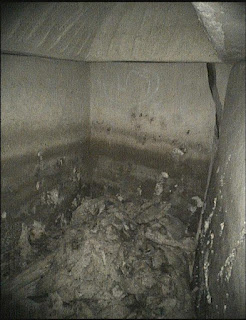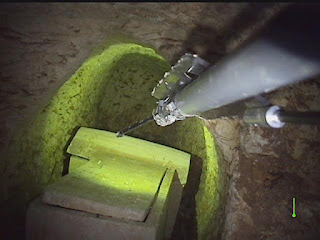Here are the details. On Monday, I gathered together some of my questions about Anomalies in the Talpiot Tomb B Photographs. Some of my questions related to apparent anomalies between the pictures taken in 1981 when Amos Kloner briefly had the chance to investigate the tomb, and the more recent pictures taken with the robotic arm. My key question, though, related to an anomaly among the recent pictures.
James Tabor's Preliminary Report, page 32, figure 7, was labelled "inside ossuary 5, kokh 3". He explained "We were able to see inside one of the ossuaries that had a piece of its end broken off (presently in kokh 3, ossuary 5)" and he noted the chalk mark "5", presumed to be from Kloner's 1981 investigation. Here is the picture:
I pointed out that this ossuary appeared to have a domed lid and that I could not see how it could be ossuary 5. Ossuary 5 (the "Resurrection Inscription" ossuary), in kokh 3, is in front of ossuary 6 (the "Jonah" ossuary) and it is clear from the photographs (Preliminary Report, p. 37, figs. 14-15 and Complete Findings) that it had a flat lid. It couldn't be the same ossuary. Take a look at one of those pictures:
 |
| "Inside ossuary 5, kokh 3", Tabor, Preliminary Report, p. 32, fig. 7. Note the domed lid. |
I pointed out that this ossuary appeared to have a domed lid and that I could not see how it could be ossuary 5. Ossuary 5 (the "Resurrection Inscription" ossuary), in kokh 3, is in front of ossuary 6 (the "Jonah" ossuary) and it is clear from the photographs (Preliminary Report, p. 37, figs. 14-15 and Complete Findings) that it had a flat lid. It couldn't be the same ossuary. Take a look at one of those pictures:
 |
| Tabor, Preliminary Report, p. 37, fig. 15, "View of the snake camera and its light approaching kokh 3". Note that Ossuary 5, in the foreground, has a flat lid. |
In comments to that post and in email correspondence, James Tabor has accepted that the supposed picture of ossuary 5 (in figure 7 of his Preliminary Report) is misidentified (also mentioned in James Tabor's blog, penultimate paragraph).
Moreover, I had speculated that fig. 7 actually depicted Ossuary 4 in kokh 2 -- see the picture in the Complete Findings, which made it a strong candidate. Notice the gap at the top right of Ossuary 4:
A commenter Ian also suggested that Ossuary 4 was a candidate for the shot. And it now seems that this is correct. While accepting that the internal picture above could not be Ossuary 5, Prof. Tabor then suggested that it might be Ossuary 2. I pressed the point that Ossuary 4 here was a better candidate and Prof. Tabor subsequently agreed and noted that he had received confirmation of this from the GE camera guy (via email to me only).
Moreover, I had speculated that fig. 7 actually depicted Ossuary 4 in kokh 2 -- see the picture in the Complete Findings, which made it a strong candidate. Notice the gap at the top right of Ossuary 4:
 |
| Ossuary 4, kokh 2, taken from Complete Findings slide, labelled "4. Plain (Not fully explored) (Ossuary in the back)". I have added the red highlight to show where I think the camera could have gone in. |
A commenter Ian also suggested that Ossuary 4 was a candidate for the shot. And it now seems that this is correct. While accepting that the internal picture above could not be Ossuary 5, Prof. Tabor then suggested that it might be Ossuary 2. I pressed the point that Ossuary 4 here was a better candidate and Prof. Tabor subsequently agreed and noted that he had received confirmation of this from the GE camera guy (via email to me only).
[Added note: I am grateful to Prof. Tabor also for sending me an as yet unpublished picture of the back end of ossuary 5 as it leans up against ossuary 6. The picture shows a hole in the ossuary (not reproduced in the museum replica) that has the same contours as the picture of ossuary 5 from 1981. This photograph satisfies me that we are looking at in that picture is the same ossuary, viewed from the opposite side.]
Update (Friday): James Tabor has now updated his article, Preliminary Report, though I must admit to a little disappointment that he did not acknowledge the source of the correction.
Update (Saturday): Photographs and captions added to the above post to make it easier for people to follow the discussion.
Update (Friday): James Tabor has now updated his article, Preliminary Report, though I must admit to a little disappointment that he did not acknowledge the source of the correction.
Update (Saturday): Photographs and captions added to the above post to make it easier for people to follow the discussion.
3 comments:
Many thanks for your sharp eyes on this Mark. I had wrongly assumed, not noticing the "lid," that if our camera people filmed inside an ossuary it must have been the broken one to which you refer. As it turns out no. 4 had the lid ajar, and that is how those pictures were produced. Either Rami or I were present for all the filming, which is required by our IAA license (directors have to be on the scene at all times) but I think I had gone into town for something the afternoon they took these shots. Anyway, we are making the corrections all around.
What is most important from this is that we can indeed identify ossuary #5 in the 1981 photo and on Kloner's map as the one with the Greek inscription, confirming it has been moved--but it is not the one that is chalked marked #5. That means we have been able to correlate the 1981 and present locations of all the ossuaries with some certainty except nos. 2 and 3--though we know they are either our ossuary 1 or ossuary 2 respectively--we just don't know which is which. Ossuary 4, which is the one we get a peak inside, has on the far end the faint Greek inscription that appears in the 1918 B&W photos. I am hoping that some sharp eyed epigrapher can decipher the name, which I have suggested might be IONAS, IONA, or JULIA...
Thanks for your comments, James. I have now updated this post by adding photographs and captions so that it is easier to follow for others.
Shalom James,
Just curious; how long were you filming and photographing at the tomb?
Post a Comment